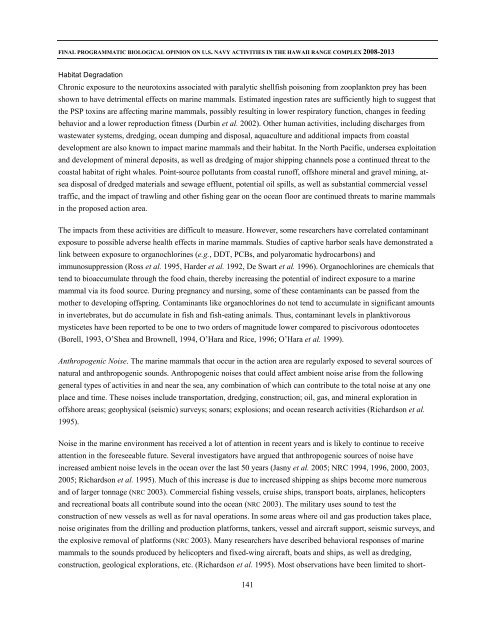NMFS Biological Opinion on U.S. Navy training ... - Govsupport.us
NMFS Biological Opinion on U.S. Navy training ... - Govsupport.us
NMFS Biological Opinion on U.S. Navy training ... - Govsupport.us
You also want an ePaper? Increase the reach of your titles
YUMPU automatically turns print PDFs into web optimized ePapers that Google loves.
FINAL PROGRAMMATIC BIOLOGICAL OPINION ON U.S. NAVY ACTIVITIES IN THE HAWAII RANGE COMPLEX 2008-2013<br />
Habitat Degradati<strong>on</strong><br />
Chr<strong>on</strong>ic exposure to the neurotoxins associated with paralytic shellfish pois<strong>on</strong>ing from zooplankt<strong>on</strong> prey has been<br />
shown to have detrimental effects <strong>on</strong> marine mammals. Estimated ingesti<strong>on</strong> rates are sufficiently high to suggest that<br />
the PSP toxins are affecting marine mammals, possibly resulting in lower respiratory functi<strong>on</strong>, changes in feeding<br />
behavior and a lower reproducti<strong>on</strong> fitness (Durbin et al. 2002). Other human activities, including discharges from<br />
wastewater systems, dredging, ocean dumping and disposal, aquaculture and additi<strong>on</strong>al impacts from coastal<br />
development are also known to impact marine mammals and their habitat. In the North Pacific, undersea exploitati<strong>on</strong><br />
and development of mineral deposits, as well as dredging of major shipping channels pose a c<strong>on</strong>tinued threat to the<br />
coastal habitat of right whales. Point-source pollutants from coastal runoff, offshore mineral and gravel mining, atsea<br />
disposal of dredged materials and sewage effluent, potential oil spills, as well as substantial commercial vessel<br />
traffic, and the impact of trawling and other fishing gear <strong>on</strong> the ocean floor are c<strong>on</strong>tinued threats to marine mammals<br />
in the proposed acti<strong>on</strong> area.<br />
The impacts from these activities are difficult to measure. However, some researchers have correlated c<strong>on</strong>taminant<br />
exposure to possible adverse health effects in marine mammals. Studies of captive harbor seals have dem<strong>on</strong>strated a<br />
link between exposure to organochlorines (e.g., DDT, PCBs, and polyaromatic hydrocarb<strong>on</strong>s) and<br />
immunosuppressi<strong>on</strong> (Ross et al. 1995, Harder et al. 1992, De Swart et al. 1996). Organochlorines are chemicals that<br />
tend to bioaccumulate through the food chain, thereby increasing the potential of indirect exposure to a marine<br />
mammal via its food source. During pregnancy and nursing, some of these c<strong>on</strong>taminants can be passed from the<br />
mother to developing offspring. C<strong>on</strong>taminants like organochlorines do not tend to accumulate in significant amounts<br />
in invertebrates, but do accumulate in fish and fish-eating animals. Th<strong>us</strong>, c<strong>on</strong>taminant levels in planktivoro<strong>us</strong><br />
mysticetes have been reported to be <strong>on</strong>e to two orders of magnitude lower compared to piscivoro<strong>us</strong> od<strong>on</strong>tocetes<br />
(Borell, 1993, O’Shea and Brownell, 1994, O’Hara and Rice, 1996; O’Hara et al. 1999).<br />
Anthropogenic Noise. The marine mammals that occur in the acti<strong>on</strong> area are regularly exposed to several sources of<br />
natural and anthropogenic sounds. Anthropogenic noises that could affect ambient noise arise from the following<br />
general types of activities in and near the sea, any combinati<strong>on</strong> of which can c<strong>on</strong>tribute to the total noise at any <strong>on</strong>e<br />
place and time. These noises include transportati<strong>on</strong>, dredging, c<strong>on</strong>structi<strong>on</strong>; oil, gas, and mineral explorati<strong>on</strong> in<br />
offshore areas; geophysical (seismic) surveys; s<strong>on</strong>ars; explosi<strong>on</strong>s; and ocean research activities (Richards<strong>on</strong> et al.<br />
1995).<br />
Noise in the marine envir<strong>on</strong>ment has received a lot of attenti<strong>on</strong> in recent years and is likely to c<strong>on</strong>tinue to receive<br />
attenti<strong>on</strong> in the foreseeable future. Several investigators have argued that anthropogenic sources of noise have<br />
increased ambient noise levels in the ocean over the last 50 years (Jasny et al. 2005; NRC 1994, 1996, 2000, 2003,<br />
2005; Richards<strong>on</strong> et al. 1995). Much of this increase is due to increased shipping as ships become more numero<strong>us</strong><br />
and of larger t<strong>on</strong>nage (NRC 2003). Commercial fishing vessels, cruise ships, transport boats, airplanes, helicopters<br />
and recreati<strong>on</strong>al boats all c<strong>on</strong>tribute sound into the ocean (NRC 2003). The military <strong>us</strong>es sound to test the<br />
c<strong>on</strong>structi<strong>on</strong> of new vessels as well as for naval operati<strong>on</strong>s. In some areas where oil and gas producti<strong>on</strong> takes place,<br />
noise originates from the drilling and producti<strong>on</strong> platforms, tankers, vessel and aircraft support, seismic surveys, and<br />
the explosive removal of platforms (NRC 2003). Many researchers have described behavioral resp<strong>on</strong>ses of marine<br />
mammals to the sounds produced by helicopters and fixed-wing aircraft, boats and ships, as well as dredging,<br />
c<strong>on</strong>structi<strong>on</strong>, geological explorati<strong>on</strong>s, etc. (Richards<strong>on</strong> et al. 1995). Most observati<strong>on</strong>s have been limited to short-<br />
141








